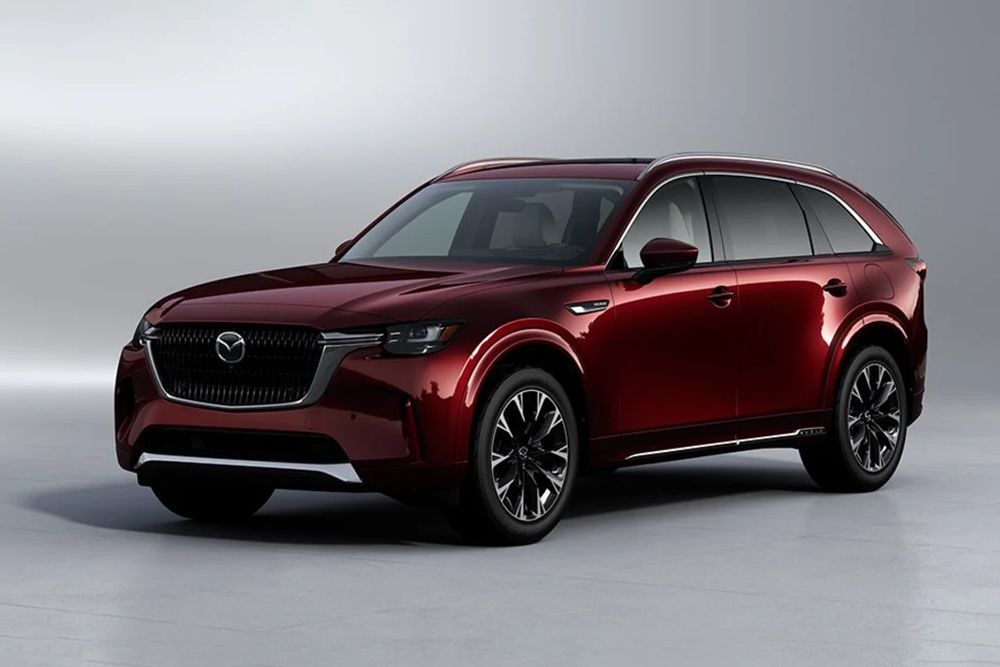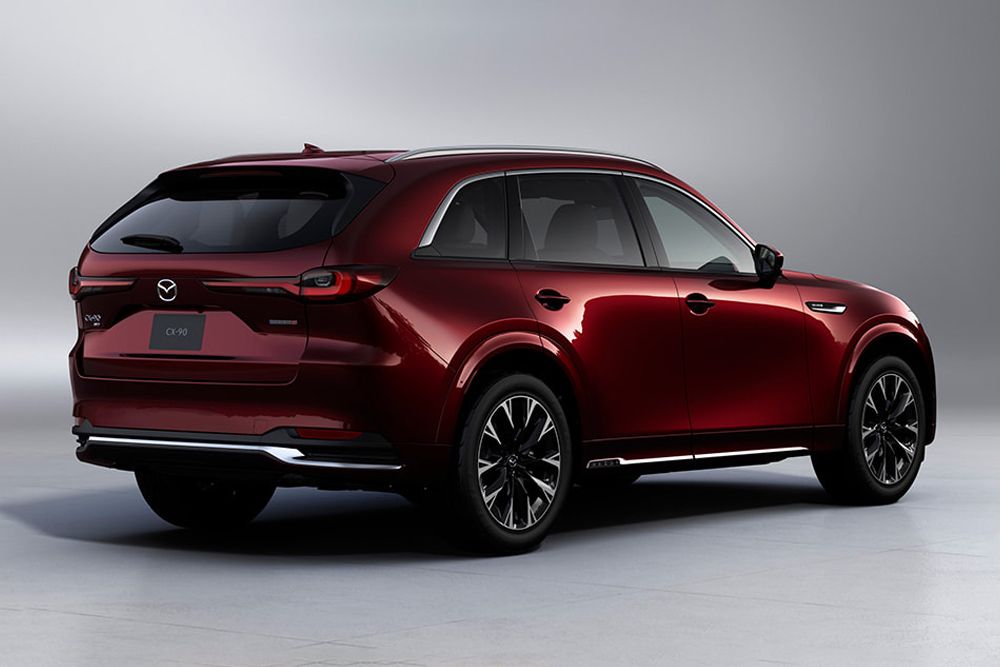
Mazda’s biggest hits the luxury SUV highs
Mazda, never a car-maker to stand still, is pushing higher into premium territory with its latest SUVs now so rich in features that buyers barely have any options to consider.
It puts the brand back where it was decades ago, as a premium Japanese manufacturer set above many of its country rivals.
Sealing the change back to a prestige brand is the CX-90, an SUV that ostensibly re-places the family-focused CX-9 but with more luxury, more equipment, more space, more technology and, more dollars.
Marketed to compete with many of the European and more lavish Asian models, Mazda turned the CX-90 (and its slightly smaller sibling, the CX-60) into a very competent tourer and cavernous transporter for up to seven occupants.
But is it for you and your family?
How much?
There are three main trim levels, two engine options and a price range of $74,400 right up to a place you’d probably never thought you’d see a Mazda - $100,935. All prices plus on-road costs.
The car tested here is the CX-90 D50E Azami Takumi diesel, listed at $99,820 plus on-road costs.
All CX-90 models come with all-wheel drive, so it’s hard to make a comparison with the outgoing CX-9 (which had the less-expensive front-drive available) but generally, the new boy is about $22,000 more expensive.
The range opens with the petrol Touring, through to the GT and Azami (which has its own three grades) and then repeated for the diesel. You’ll pay an extra $2000 for the Touring diesel but the rest of the petrol versions are actually more expensive than their diesel counterparts.
Ownership costs will often play a part on which fuel type you decide but in the case of the CX-90, many buyers are likely to overlook the slightly higher fuel use and opt for the silk-ier petrol engine.
How Big?
The Mazda CX-9 was no short-stop and the CX-90 certainly ups the dimensions. It’s 5.12m long and 1.994m wide, so can be a big machine in some garages and carports and, for city owners, many carparks.
That makes it a modest 45mm longer than the CX-9 and 25mm wider, so if you’re up-grading, it shouldn’t be too much of a hassle.
Interestingly, the new model has a tighter tuning circle. This is attributed to its in-line drivetrain that creates a narrow engine line compared with the transverse engine of the CX-9 that makes the engine bay wider, and limits suspension and steering movement.
The CX-90 can turn in a 10.8m circle, while the CX-9 needs a wider 11.8m. So the new car is longer, but likely easier to park.
While we’re talking length, the CX-90 has a much longer 3.12m wheelbase, up 190mm on the CX-9, which promptly gives it more passenger and cargo space.
There’s nothing wanting in terms of cabin room. The CX-90 is not only expansive, it looks great and has heaps of features (think heated front and rear seats, model dependant) to really cocoon its occupants.
As a seven seater it has more legroom for the two occupants in the third row, making it more suitable to bigger children. Adults could fit, but it’s still a bit of a squeeze.
The second row has excellent leg and headroom and the seats have plenty of fore-aft and recline adjustment.
How fast?
It seems odd that Mazda would ditch a turbo-petrol four-cylinder engine of 2.5-litres and replace it with a potentially thirstier in-line six-cylinder engine of 3.3 litres. But it did.
Much of this is about the drive experience. An inline six is smooth, quiet and sits longitu-dinally in the car’s frame for better balance, accessibility and to give space for other com-ponents including suspension and steering components.
Mazda continues to push the ‘zoom-zoom’ theme as its lure for owners who enjoy driv-ing, so what’s been applied to the latest SUV is all about driving appeal.
And it works. The CX-90 is a big car not only in length as it tops out at about 2.2 tonnes in weight, up about 300kg on the outgoing CX-9.
Making this feel agile and sprinkled with ‘zoom-zoom’ is no easy ask, but the balance of the SUV is very good and owners should be pleased that its road manners are indeed competent, even enjoyable.
The diesel version tested here has strong torque (550Nm at a low 1500-2400rpm) which gives it a seamless flow of power that's always on call. It’s punchy, too, and although some turbo-diesels have an irritating ‘lag’ where the power takes time to come on steam, Mazda has an answer.
The CX-90 has a mild-hybrid system where an ancillary electric motor gives an extra dose of power. It’s not huge, but it fills in any shortfall. Better, it’s not a complex system and requires no input from the driver.
Another change with this new SUV is Mazda’s automatic transmission. It has moved up from the six-speed unit of the CX-9 to an eight-speed box that has no torque converter. Instead, it uses a multi-plate clutch pack. This is simpler, lighter and smaller than the pre-vious transmission.
But it can be a bit abrupt, with some gearshift bumps felt when slowing down or when the accelerator is quickly applied.
How thirsty?
Mazda claims an average of 5.4 litres/100km for the diesel which gives it a theoretical range of a whopping 1370km. Perhaps that’s a bit optimistic as the long road test on this car in mainly suburban conditions returned 6.8 L/100km, enough to send you back to the service station at 1088km — still pretty good fo a vehicle of this size.
What’s inside?
The price tag is the first indication that there’s a lot to offer in the feature list of the CX-90. But it’s relevant, of course, to the model you choose. Sticking with the CX-90 D50E Azami Takumi as tested, that spells a lot of top-end gear.
Just as a heads up on all those Japanese names - Azami is the grade and Takumi is the option pack that makes the SUV even more special by adding things like pure-white nappa leather seat upholstery; an unusual cloth dashboard panel with Kakenui stitching (hints at the cloth used in Tokyo taxis); white maple wood console and door trim inserts; and two captain’s seats in the second row, making it a six seater.
This may be all over-the-top for most buyers (and the white cloth dash panel may have a use-by date of sushi if it meets kids and/or coffee) but it certainly makes this version a talking piece.
The standard equipment for the Azami is extensive, including three digital screens (two at 12.3-inches each) fo the infotainment, communications, sat-nav and driver’s needs. There’s also Apple CarPlay and Android Auto; USB ports and even a 150-watt mains plug for a car fridge; 12-speaker audio with digital radio; wireless phone charger; LED headlights; 10-way electric driver’s seat and eight way for the front passenger; heated and vented from seats with the second row outer seats also having heating.
How much room?
Treat it as a seven-seater and there’s 275 litres of space at the back, plus some storage under the false floor. Pop the third row flat (it sits in it’s own compartment) and there’s a generous 608 litres available and then fold down the second row for 2025 litres of flat floor. There's a space-saver spare under the rear boot floor.
How safe?
The CX-90 has yet to be crash tested by the Australasian New Car Assessment program (ANCAP) but its sibling, the CX-60, has achieved the full five stars which indicates the bigger SUV should fare as highly.
There’s a comprehensive safety inventory aboard the CX-90, including eight airbags — including a driver’s knee bag, front-centre airbag and curtain bags for all three seat rows — and a full suite of autonomous emergency braking (AEB) programs including front and rear cross-traffic monitoring and mitigation, rear cross traffic sensing and turn-cross moni-toring.
In addition, there’s 360-degree cameras, lane-keep assist, lane-follow assistance, blind-spot warning with collision avoidance, and an exit warning for occupants when there’s approaching traffic.
All CX-90s have adaptive cruise but the Azami versions also have a system that will bring the car to a complete stop.
Service costs?
Mazda offers a five-year, unlimited distance warranty that has become the norm for the industry.
The CX-90 has service intervals set at 12 months or a relatively low 10,000km, when ri-vals are spaced at 12.000km intervals.
The is a five-year capped price service program. Prices are $2096 for three years and $3217 fo five years.
Rivals?
Audi Q7 45TDI: $108,469
Hyundai Palisade Calligraphy Black Ink: $80,900*
Genesis GV80 3.0D: $105,700*
Jaguar F-Pace D300 SE: $105,300*
Volkswagen Touareg 210TDI: $105,300*
* plus on-road costs
Pricing?
The CX-90 D50E Azami Takumi diesel is listed at $99,820 plus on-road costs.
Once you've found the right car, the next step is sorting out car finance that actually works for your budget. Credit One is Australia's best-reviewed finance broker, with 3,000+ five-star Google reviews from customers who've been through the process. Check out Credit One reviews to see what people say, or head straight to the loan repayment calculator to see what the numbers look like.